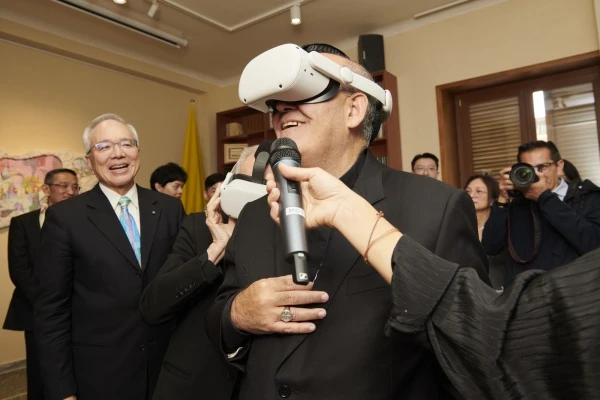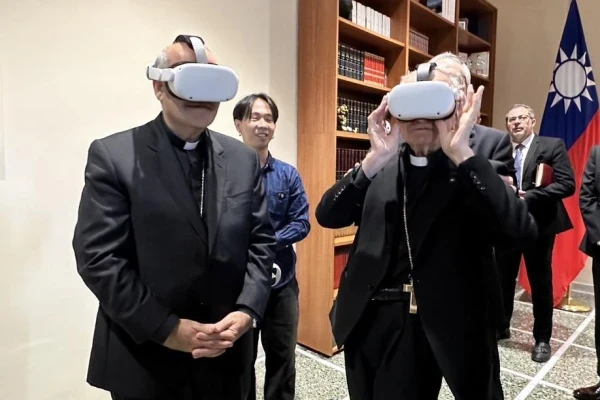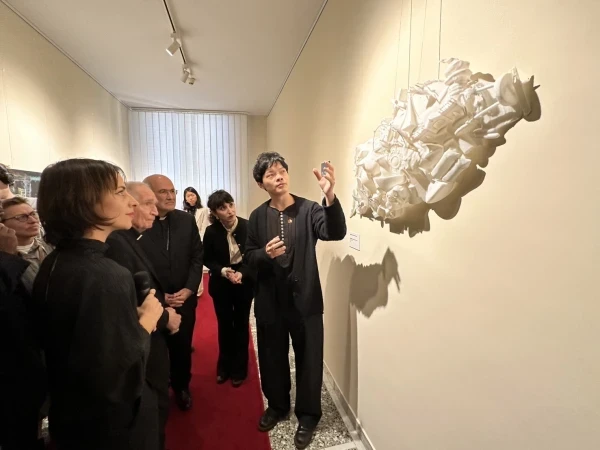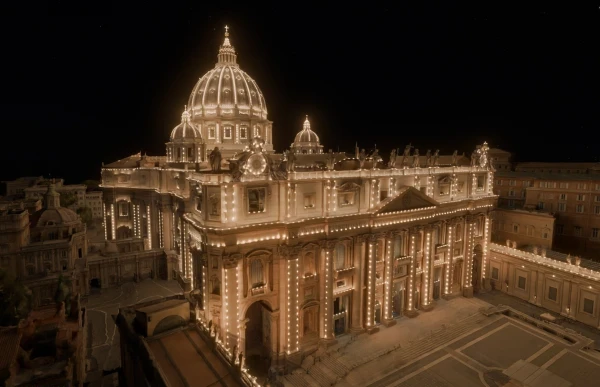This week, Catholic cardinals wore virtual reality headsets during the inauguration of an innovative contemporary art exhibition, inspired by artificial intelligence, for the Jubilee Year 2025.
The exhibition, titled “Interconnected Hearts: Taiwan Contemporary Art Exhibition 2024,” is being held at the Embassy of the Republic of China to the Holy See, just steps from St. Peter’s Square. The exhibition features works created by three Taiwanese artists using technologies such as 3D scanning, virtual reality (VR), machine learning (machine learning) and artificial intelligence (AI).
Receive the main news from ACI Prensa by WhatsApp and Telegram
It is increasingly difficult to see Catholic news on social media. Subscribe to our free channels today:
Among the first to test the virtual reality headsets at the inauguration Among the first to test them, on November 11, was Cardinal Silvano María Tomasi, 84, special delegate to the Sovereign Military Hospitaller Order of Saint John of Jerusalem, of Rhodes and Malta.
Cardinal José Tolentino de Mendonça, prefect of the Vatican Dicastery for Culture and Education, described the art exhibition as “intriguing and extremely innovative.”

Using virtual reality headsets from Meta, Cardinal Tolentino experienced a work by Hung Yu Hao, which digitally unites architectural elements from Taiwan and St. Peter’s Square in a shared virtual space.
“The works that we have before our eyes today flow from the creativity of human genius, enhanced by the use of artificial intelligence,” declared the Portuguese cardinal.
Taiwan’s embassy to the Holy See sponsored the art exhibition as a testament to Pope Francis’ commitment to examining the ethical implications of AI, both in its message for the World Day of Peace 2024 as in your speech at the G7 in Puglia.

At the opening, Ambassador Matthew Lee highlighted how Taiwan is “at the forefront of AI technology with great ingenuity and human resources.”
Taiwan President Lai Ching-te has declared his commitment to transforming Taiwan into an “AI Island.”
The ambassador noted that the exhibition, which will be open until February 14, 2025, has been officially added to the jubilee cultural events calendar by the Dicastery for Evangelization.
“The Chinese title of the art exhibition, ‘心信相連,’ expresses that the hearts of the faithful are connected with God, full of faith towards Him, thus forging unwavering trust in God,” Lee noted.

As the Vatican embraces new technologies, the Church remains aware of the ethical implications of AI. Cardinal Tolentino noted that Pope Francis has described the potential of AI to lead us to “a cognitive-industrial revolution.”
The cardinal added that this “magnificent new tool” must “always be at the service of the weakest and neediest and never be a tool of domination and oppression.” “Only in this way will we affirm and strengthen our humanity,” he added.
A high-tech week for the world’s oldest institution also included a Vatican collaboration with Microsoft.
Brad Smith, vice president and president of Microsoft, presented a 3D digital model of St. Peter’s Basilicadeveloped using advanced AI, allowing virtual visitors from around the world to explore the art and history of the basilica.

“It is literally one of the most advanced and sophisticated projects of its kind ever undertaken,” shared Smith, who has been a leading partner in the Vatican’s AI ethics initiatives.
The Microsoft president also announced the launch of an educational Minecraft game exploring St. Peter’s Basilica, expected in January 2025, and a new immersive in-person exhibition on the terrace of St. Peter’s Basilica for the jubilee year. of the Catholic Church.
Translated and adapted by the ACI Prensa team. Originally published in CNA.

